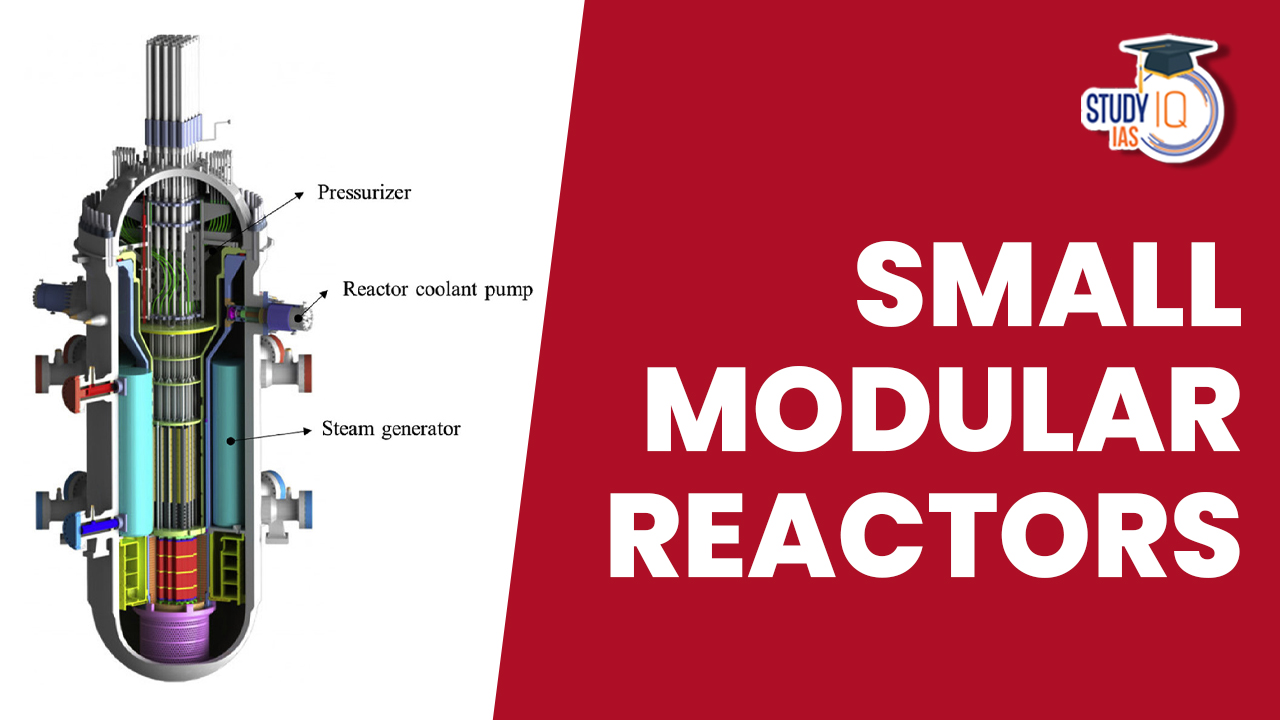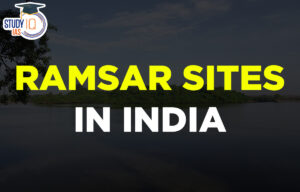Table of Contents
Context: Recent studies have found that Small Modular Reactors (SMRs) can be safely installed and operated at brownfield sites that may not meet the more stringent zoning requirements for conventional Nuclear Power Plants (NPPs).
Understanding Nuclear Energy NPPs and SMRs:
Nuclear Energy
- Nuclear energy is a type of energy that is generated by the process of nuclear reactions- either nuclear fission or nuclear fusion.
- The energy released during these reactions can be harnessed and used to produce electricity, heat, or other forms of energy.
- Nuclear fission: It is a process in which the nucleus of an atom is split into two or more smaller nuclei, releasing a large amount of energy in the process.
- This process is used in nuclear power plants to generate electricity.
- One example of nuclear fission is the reaction that occurs in a nuclear reactor when uranium atoms are split into smaller atoms.
- Nuclear fusion: It is a process in which two or more atomic nuclei come together to form a single, more massive nucleus, releasing a large amount of energy in the process.
- This process occurs naturally in stars, including our own sun.
- One example of nuclear fusion is the reaction that occurs in a hydrogen bomb.
Advantages of Nuclear Energy

Role of Nuclear Energy in Energy Transition across the Globe
- Energy transition is the process of revamping global energy systems through rapid introduction of low-emission energy supply technologies, and aggressive penetration of non-fossil-based energy sources in the primary energy mix.
- According to the International Atomic Energy Agency (IAEA), as of April 2023, 413 nuclear power reactors with a total net installed power generating capacity of 368 GW(e) are in operation globally, which is projected to rise to 871 GW by 2050, more than doubling the current capacity.
- The share of nuclear power generation is nearly 10% of the global electricity mix.
- As per IAEA, the nuclear power has avoided the CO2 emissions of 70 Gt over the past five decades and it continues to avoid CO2 emissions of about 1 Gt annually.
- The IEA acknowledges the role of nuclear energy in energy transition. The UN Economic Commission for Europe (UNECE) has stated that nuclear power is an “indispensable tool” for achieving the Sustainable Development Goals (SDGs).
Issues with Nuclear Power
- Safety Concerns: One of the most significant concerns with nuclear power is the potential for accidents and radioactive releases. High-profile incidents like Chernobyl and Fukushima have highlighted the catastrophic consequences of nuclear accidents.
- Radioactive Waste: Nuclear power generates radioactive waste that remains hazardous for thousands of years. Finding suitable long-term storage solutions for this waste is a complex and controversial issue. Improper disposal or storage can pose risks to human health and the environment.
- Nuclear Proliferation: The spread of nuclear technology and materials raises concerns about nuclear weapons proliferation. The same technology used for peaceful power generation can potentially be misused for developing nuclear weapons.
- High Initial Costs and Financing: The construction of nuclear power plants requires substantial upfront capital investments and often faces delays and cost overruns. Securing financing for these large-scale projects can be challenging, and these costs can make nuclear power less economically competitive compared to other energy sources.
- Limited Fuel Supply: Nuclear power relies on uranium fuel, which is a finite resource. While there are technologies to extract more energy from uranium and use alternative fuels like thorium, concerns about long-term fuel availability persist.
- Complex Regulatory Environment: The regulatory framework for nuclear power is complex and stringent due to safety and security concerns. Navigating these regulations can add to the time and cost of nuclear projects.
- Decommissioning and Site Remediation: When a nuclear power plant reaches the end of its operational life, decommissioning and cleaning up the site can be a complex and costly process. Managing and funding these activities is a challenge for many countries.
- Environmental Impact: While nuclear power generates low direct carbon emissions during operation, the entire nuclear fuel cycle, including mining, processing, and waste management, can have environmental impacts, including greenhouse gas emissions.
Small modular reactors (SMRs) aim to address some of these challenges by offering potential benefits like easier financing, enhanced safety features, and more flexible deployment options. Bottom of Form
Various Types of Nuclear Reactor Technologies
- The nuclear industry has been developing several types of nuclear reactors with progressive increase in reactor capacity and improvement in safety features, performance, and economics.
- At present, nuclear power reactors of various types are in operation like PWRs, BWRs, PHWRs, FBRs, HTGRs etc.
- Pressurized Water Reactor (PWR): They use enriched uranium as fuel and employ water as both coolant and moderator.
- Boiling Water Reactor (BWR): BWRs are similar to PWRs but differ in their design. In BWRs, the water in the primary circuit boils directly due to heat generated by fission.
- Pressurized Heavy Water Reactor (PHWR): They use heavy water (deuterium oxide) as both the coolant and moderator.
- Fast Breeder Reactor (FBR): It is a type of nuclear reactor that uses fast neutrons to sustain the nuclear chain reaction.
- High-Temperature Gas-Cooled Reactor (HTGR): It is a type of nuclear reactor that uses helium gas as a coolant and graphite as a moderator.
- Among the various reactor types, PWRs are at the top with more than 300 operating reactors in the world at present.
Emergence of Small Modular Reactors (SMRs)
- Roots of SMRs can be traced back to 1940s-1950s when small capacity nuclear reactors of various designs were used for military purposes.
- As per the IAEA, the SMRs are advanced nuclear reactors with a power generation capacity ranging from less than 30 MWe to 300+ MWe.
- SMRs are:
- Small – physically a fraction of the size of a conventional nuclear power reactor.
- Modular – making it possible for systems and components to be factory-assembled and transported as a unit to a location for installation.
- Reactors – harnessing nuclear fission to generate heat for electricity production or direct application.
- Many countries have active national programmes dedicated to SMR design and technology development with a view to deploy them by 2035 with extensive global cooperation.
- SMR designs can be categorised into six types based on the basic nuclear technology employed in the design:
- Land-based water-cooled SMRs: This category includes SMRs that use water as a coolant and moderator, following the principles of pressurized water reactors (PWRs) commonly found in large nuclear power plants.
- Marine based water cooled SMRs: SMRs in this category include the water-cooled SMR designs for deployment in a marine environment. This can be achieved in the form of floating units installed on barges or ships.
- High temperature gas-cooled SMRs: SMRs from this category can provide very high temperature heat of more than 750 degrees Celsius and thereby higher efficiency in electricity generation.
- Liquid metal-cooled fast neutron spectrum SMRs (LMFRs): SMRs in this category include designs based on fast neutron technology with different coolant options including helium gas and liquid metal coolants like sodium, lead and lead-bismuth.
- Molten Salt Reactor SMRs (MSRs): SMRs in this category are based on molten fluoride or chloride salt in the role of coolant.
- Microreactors (MRs): MRs are very small SMRs designed to generate electrical power typically up to 10 MW(e). Different types of coolant, including light water, helium, molten salt and liquid metal are adopted by microreactors.
Key features and benefits of Small Modular Reactors (SMRs)
Small Modular Reactors (SMRs) offer several advantages compared to conventional Nuclear Power Plants (NPPs), making them an attractive option for addressing energy needs and environmental concerns. These benefits include:
- Enhanced Safety Features: SMRs are designed with improved safety measures, including lower core damage frequency and reduced radioactive contamination potential. Their simpler design and passive safety features contribute to a decreased risk of uncontrolled radioactive releases during accidents.
- Seismic Resilience: Many SMR designs incorporate enhanced seismic isolation, making them more resilient to earthquakes and other natural disasters, thereby increasing overall plant safety.
- Reduced Environmental Impact: SMRs produce less radioactive waste than conventional NPPs, and their smaller size enables more efficient waste management. This can help mitigate long-term environmental and disposal challenges.
- Size and Portability: SMRs are smaller and more compact than conventional reactors, allowing for easier transport, installation, and scalability. Their smaller size and modular nature make them suitable for deployment in remote areas or as a supplement to existing power grids, enhancing grid resilience.
- Reduced Capital Costs: The modular design of SMRs allows for standardized manufacturing processes, potentially reducing construction costs.
- Potential for Decentralization: SMRs offer the potential for decentralized power generation, allowing communities or industries to have their own local sources of electricity.
- Integration with Renewable Energy: SMRs can complement renewable energy sources, such as solar and wind, by providing baseload power and maintaining grid stability during periods of low renewable generation.
- Flexibility in Siting: SMRs can be safely installed on brownfield sites, which might not meet the stringent requirements of larger NPPs. This allows for repurposing existing infrastructure and avoids potential conflicts over land use.
- Community Engagement: SMR projects can engage with local communities, fostering support and collaboration similar to successful instances like the Kudankulam project in Tamil Nadu.
- Energy Security: Deploying SMRs can enhance energy security by diversifying the energy mix and reducing dependence on fossil fuels. Additionally, uranium resources are more widely distributed than critical minerals, ensuring a more stable supply chain.
- Economic Viability: The levelized cost of electricity for SMRs is competitive, ranging from $60-90 per MWh. Anticipated advancements in technology and manufacturing are projected to lead to even more cost reductions, especially as more SMR projects come online.
- Long Operational Lifespan: SMRs are designed to operate for over 40 years, providing a reliable and stable source of electricity over an extended period.
Challenges associated with SMRs
- Technology choice issue: Many SMR technology alternatives are available at present with varying requirements of supply chains, regulation, operations, etc. For large scale commercial deployment of SMRs, the technology choice needs prioritization.
- Supply chain issues: As with big LWRs (Light Water Reactors), the supply chain is an important factor in SMR competitiveness. Supply chains for the SMR industry may need consolidation in order to capitalize on economies of scale, as witnessed in the aviation industry.
- Safeguards challenges: In most countries, novel SMR technologies will require the application of international safeguards, potentially requiring the development of novel or customized technical measures that demand time and resources, typically in collaboration with the relevant governments and industry.
- Potential disadvantages: SMRs also produce radioactive waste from spent fuel and require spent fuel storage & disposal facilities. Apart from the technological and cost aspects of such a requirement, this requirement can also lead to socio-political resistance.
- Public perception and engagement: Nuclear power has faced traditional opposition due to the potential consequences of a nuclear disaster, notwithstanding the low likelihood of such events.
Need for an efficient regulatory regime
- For Small Modular Reactors (SMRs) to effectively contribute to decarbonizing the power sector, it is imperative to establish a robust regulatory framework akin to the stringent safety standards observed in the civil aviation sector.
- Achieving this goal requires collaborative efforts among nations that embrace nuclear energy, guiding their regulatory authorities to cooperate with each other and the International Atomic Energy Agency.
- The aim is to synchronize regulatory prerequisites and accelerate official endorsements for SMRs, particularly those built upon universally accepted designs.
What are the legal and regulatory changes required?
- The Atomic Energy Act will need to be amended to allow the private sector to set up SMRs.
- To ensure safety, security, and safeguards, control of nuclear fuel and radioactive waste must continue to lie with the Government of India.
- The government will also have to enact a law to create an independent, empowered regulatory board with the expertise and capacity to oversee every stage of the nuclear power generation cycle.
- The security around SMRs must remain under government control, while the Nuclear Power Corporation can operate privately-owned SMRs during the hand-holding process.
- Finally, the Department of Atomic Energy must improve the public perception of nuclear power in India by better disseminating comprehensive environmental and public health data of the civilian reactors, which are operating under international safeguards, in India.


 UPSC CDS 1 Final Result 2025 Declared: D...
UPSC CDS 1 Final Result 2025 Declared: D...
 Ramsar Sites in India 2025 List: Names, ...
Ramsar Sites in India 2025 List: Names, ...
 SEBI’s SWAGAT-FI Framework for Low-Ris...
SEBI’s SWAGAT-FI Framework for Low-Ris...

























